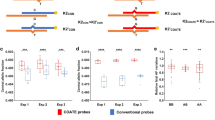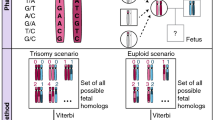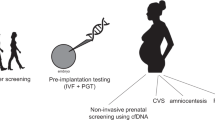Abstract
Over the past 40 years, much effort has been spent on developing non-invasive prenatal diagnostic methods. Since 1997, the progress of this field has been accelerated by the unexpected finding of extracellular fetal nucleic acids in maternal plasma. These developments have been translated into many novel genetic, epigenetic and gene-expression markers, and are expected to have a fundamental impact on the future practice of prenatal diagnosis.
This is a preview of subscription content, access via your institution
Access options
Subscribe to this journal
Receive 12 print issues and online access
$189.00 per year
only $15.75 per issue
Buy this article
- Purchase on Springer Link
- Instant access to full article PDF
Prices may be subject to local taxes which are calculated during checkout


Similar content being viewed by others
References
Chen, X. Q. et al. Microsatellite alterations in plasma DNA of small cell lung cancer patients. Nature Med. 2, 1033–1035 (1996).
Lo, Y. M. D. et al. Presence of fetal DNA in maternal plasma and serum. Lancet 350, 485–487 (1997).
Finning, K. M., Martin, P. G., Soothill, P. W. & Avent, N. D. Prediction of fetal D status from maternal plasma: introduction of a new noninvasive fetal RHD genotyping service. Transfusion 42, 1079–1085 (2002).
Chan, K. C. A. et al. Size distributions of maternal and fetal DNA in maternal plasma. Clin. Chem. 50, 88–92 (2004).
Lo, Y. M. D. et al. Quantitative analysis of fetal DNA in maternal plasma and serum: implications for noninvasive prenatal diagnosis. Am. J. Hum. Genet. 62, 768–775 (1998).
Guibert, J. et al. Kinetics of SRY gene appearance in maternal serum: detection by real time PCR in early pregnancy after assisted reproductive technique. Hum. Reprod. 18, 1733–1736 (2003).
Lo, Y. M. D. et al. Rapid clearance of fetal DNA from maternal plasma. Am. J. Hum. Genet. 64, 218–224 (1999).
Botezatu, I. et al. Genetic analysis of DNA excreted in urine: a new approach for detecting specific genomic DNA sequences from cells dying in an organism. Clin. Chem. 46, 1078–1084 (2000).
Zhong, X. Y. et al. Cell-free DNA in urine: a marker for kidney graft rejection, but not for prenatal diagnosis? Ann. NY Acad. Sci. 945, 250–257 (2001).
Smid, M. et al. No evidence of fetal DNA persistence in maternal plasma after pregnancy. Hum. Genet. 112, 617–618 (2003).
Rijnders, R. J., Christiaens, G. C., Soussan, A. A. & van der Schoot, C. E. Cell-free fetal DNA is not present in plasma of nonpregnant mothers. Clin. Chem. 50, 679–681 (2004).
Invernizzi, P. et al. Presence of fetal DNA in maternal plasma decades after pregnancy. Hum. Genet. 110, 587–591 (2002).
Bianchi, D. W., Zickwolf, G. K., Weil, G. J., Sylvester, S. & DeMaria, M. A. Male fetal progenitor cells persist in maternal blood for as long as 27 years postpartum. Proc. Natl Acad. Sci. USA 93, 705–708 (1996).
Masuzaki, H. et al. Detection of cell free placental DNA in maternal plasma: direct evidence from three cases of confined placental mosaicism. J. Med. Genet. 41, 289–292 (2004).
Chim, S. S. C. et al. Detection of the placental epigenetic signature of the maspin gene in maternal plasma. Proc. Natl Acad. Sci. USA 102, 14753–14758 (2005).
Tjoa, M. L., Cindrova-Davies, T., Spasic-Boskovic, O., Bianchi, D. W. & Burton, G. J. Trophoblastic oxidative stress and the release of cell-free feto-placental DNA. Am. J. Pathol. 169, 400–404 (2006).
Lo, Y. M. D. et al. Quantitative abnormalities of fetal DNA in maternal serum in preeclampsia. Clin. Chem. 45, 184–188 (1999).
Levine, R. J. et al. Two-stage elevation of cell-free fetal DNA in maternal sera before onset of preeclampsia. Am. J. Obstet. Gynecol. 190, 707–713 (2004).
Chiu, R. W. K. et al. Effects of blood processing protocols on fetal and total DNA quantification in maternal plasma. Clin. Chem. 47, 1607–1613 (2001).
Chiu, R. W. K. et al. Comparison of protocols for extracting circulating DNA and RNA from maternal plasma. Clin. Chem. 51, 2209–2210 (2005).
Costa, J. M., Benachi, A. & Gautier, E. New strategy for prenatal diagnosis of X-linked disorders. N. Engl. J. Med. 346, 1502 (2002).
Rijnders, R. J., van der Schoot, C. E., Bossers, B., de Vroede, M. A. & Christiaens, G. C. Fetal sex determination from maternal plasma in pregnancies at risk for congenital adrenal hyperplasia. Obstet. Gynecol. 98, 374–378 (2001).
Lo, Y. M. D. et al. Prenatal diagnosis of fetal RHD status by molecular analysis of maternal plasma. N. Engl. J. Med. 339, 1734–1738 (1998).
Tang, N. L. S., Leung, T. N., Zhang, J., Lau, T. K. & Lo, Y. M. D. Detection of fetal-derived paternally inherited X-chromosome polymorphisms in maternal plasma. Clin. Chem. 45, 2033–2035 (1999).
Amicucci, P., Gennarelli, M., Novelli, G. & Dallapiccola, B. Prenatal diagnosis of myotonic dystrophy using fetal DNA obtained from maternal plasma. Clin. Chem. 46, 301–302 (2000).
Chiu, R. W. K. et al. Prenatal exclusion of β-thalassaemia major by examination of maternal plasma. Lancet 360, 998–1000 (2002).
Ding, C. et al. MS analysis of single-nucleotide differences in circulating nucleic acids: application to noninvasive prenatal diagnosis. Proc. Natl Acad. Sci. USA 101, 10762–10767 (2004).
Leung, T. N., Zhang, J., Lau, T. K., Hjelm, N. M. & Lo, Y. M. D. Maternal plasma fetal DNA as a marker for preterm labour. Lancet 352, 1904–1905 (1998).
Lo, Y. M. D. et al. Increased fetal DNA concentrations in the plasma of pregnant women carrying fetuses with trisomy 21. Clin. Chem. 45, 1747–1751 (1999).
Lee, T. et al. Down syndrome and cell-free fetal DNA in archived maternal serum. Am. J. Obstet. Gynecol. 187, 1217–1221 (2002).
Li, Y. et al. Detection of paternally inherited fetal point mutations for β-thalassemia using size-fractionated cell-free DNA in maternal plasma. JAMA 293, 843–849 (2005).
Lui, Y. Y. N. et al. Predominant hematopoietic origin of cell-free DNA in plasma and serum after sex-mismatched bone marrow transplantation. Clin. Chem. 48, 421–427 (2002).
Lui, Y. Y. N. et al. Origin of plasma cell-free DNA after solid organ transplantation. Clin. Chem. 49, 495–496 (2003).
Dhallan, R. et al. Methods to increase the percentage of free fetal DNA recovered from the maternal circulation. JAMA 291, 1114–1119 (2004).
Chung, G. T. et al. Lack of dramatic enrichment of fetal DNA in maternal plasma by formaldehyde treatment. Clin. Chem. 51, 655–658 (2005).
Chinnapapagari, S. K., Holzgreve, W., Lapaire, O., Zimmermann, B. & Hahn, S. Treatment of maternal blood samples with formaldehyde does not alter the proportion of circulatory fetal nucleic acids (DNA and mRNA) in maternal plasma. Clin. Chem. 51, 652–655 (2005).
Poon, L. L. M., Leung, T. N., Lau, T. K., Chow, K. C. & Lo, Y. M. D. Differential DNA methylation between fetus and mother as a strategy for detecting fetal DNA in maternal plasma. Clin. Chem. 48, 35–41 (2002).
Grunau, C., Clark, S. J. & Rosenthal, A. Bisulfite genomic sequencing: systematic investigation of critical experimental parameters. Nucleic Acids Res. 29, e65 (2001).
Poon, L. L. M., Leung, T. N., Lau, T. K. & Lo, Y. M. D. Presence of fetal RNA in maternal plasma. Clin. Chem. 46, 1832–1834. (2000).
Ng, E. K. O. et al. Presence of filterable and nonfilterable mRNA in the plasma of cancer patients and healthy individuals. Clin. Chem. 48, 1212–1217 (2002).
Tsui, N. B. Y., Ng, E. K. O. & Lo, Y. M. D. Stability of endogenous and added RNA in blood specimens, serum, and plasma. Clin. Chem. 48, 1647–1653 (2002).
Ng, E. K. O. et al. mRNA of placental origin is readily detectable in maternal plasma. Proc. Natl Acad. Sci. USA 100, 4748–4753 (2003).
Tsui, N. B. Y. et al. Systematic microarray-based identification of placental mRNA in maternal plasma: towards non-invasive prenatal gene expression profiling. J. Med. Genet. 41, 461–467 (2004).
Oudejans, C. B. M. et al. Detection of chromosome 21-encoded mRNA of placental origin in maternal plasma. Clin. Chem. 49, 1445–1449 (2003).
Go, A. T. et al. Detection of placental transcription factor mRNA in maternal plasma. Clin. Chem. 50, 1413–1414 (2004).
Wong, B. C. K. et al. Circulating placental RNA in maternal plasma is associated with a preponderance of 5′ mRNA fragments: implications for noninvasive prenatal diagnosis and monitoring. Clin. Chem. 51, 1786–1795 (2005).
Gupta, A. K. et al. Detection of fetal DNA and RNA in placenta-derived syncytiotrophoblast microparticles generated in vitro. Clin. Chem. 50, 2187–2190 (2004).
Ng, E. K. O. et al. The concentration of circulating corticotropin-releasing hormone mRNA in maternal plasma is increased in preeclampsia. Clin. Chem. 49, 727–731 (2003).
Masuzaki, H. et al. Clinical applications of plasma circulating mRNA analysis in cases of gestational trophoblastic disease. Clin. Chem. 51, 1261–1263 (2005).
Lo, Y. M. D. et al. Plasma placental RNA allelic ratio permits noninvasive prenatal chromosomal aneuploidy detection. Nature Med. (in the press).
Tong, Y. K. et al. Noninvasive prenatal detection of fetal trisomy 18 by epigenetic allelic ratio analysis in maternal plasma: theoretical and empirical considerations. Clin. Chem. 13 Oct 2006 (doi:10.1373/clinchem.2006.076851).
Malone, F. D. et al. First-trimester or second-trimester screening, or both, for Down's syndrome. N. Engl. J. Med. 353, 2001–2011 (2005).
Bianchi, D. W. At-home fetal DNA gender testing: caveat emptor. Obstet. Gynecol. 107, 216–218 (2006).
Bianchi, D. W., Flint, A. F., Pizzimenti, M. F., Knoll, J. H. & Latt, S. A. Isolation of fetal DNA from nucleated erythrocytes in maternal blood. Proc. Natl Acad. Sci. USA 87, 3279–3283 (1990).
Herzenberg, L. A., Bianchi, D. W., Schroder, J., Cann, H. M. & Iverson, G. M. Fetal cells in the blood of pregnant women: detection and enrichment by fluorescence-activated cell sorting. Proc. Natl Acad. Sci. USA 76, 1453–1455 (1979).
Beroud, C. et al. Prenatal diagnosis of spinal muscular atrophy by genetic analysis of circulating fetal cells. Lancet 361, 1013–1014 (2003).
Bianchi, D. W. et al. Fetal gender and aneuploidy detection using fetal cells in maternal blood: analysis of NIFTY I data. National Institute of Child Health and Development Fetal Cell Isolation Study. Prenat. Diagn. 22, 609–615 (2002).
Cheung, M. C., Goldberg, J. D. & Kan, Y. W. Prenatal diagnosis of sickle cell anaemia and thalassaemia by analysis of fetal cells in maternal blood. Nature Genet. 14, 264–268 (1996).
Bianchi, D. W. et al. PCR quantitation of fetal cells in maternal blood in normal and aneuploid pregnancies. Am. J. Hum. Genet. 61, 822–829 (1997).
Chiu, R. W. K. et al. Noninvasive prenatal exclusion of congenital adrenal hyperplasia by maternal plasma analysis: a feasibility study. Clin. Chem. 48, 778–780 (2002).
Lau, T. K., Lo, K. W., Chan, L. Y. S., Leung, T. Y. & Lo, Y. M. D. Cell-free fetal deoxyribonucleic acid in maternal circulation as a marker of fetal-maternal hemorrhage in patients undergoing external cephalic version near term. Am. J. Obstet. Gynecol. 183, 712–716 (2000).
Lazar, L., Nagy, B., Ban, Z., Nagy, G. R. & Papp, Z. Presence of cell-free fetal DNA in plasma of women with ectopic pregnancies. Clin. Chem. 52, 1599–1601 (2006).
Sekizawa, A. et al. Increased cell-free fetal DNA in plasma of two women with invasive placenta. Clin. Chem. 48, 353–354 (2002).
Acknowledgements
The work in the authors' laboratories is supported by the Hong Kong Research Grants Council, the Innovation and Technology Fund and the Li Ka Shing Foundation.
Author information
Authors and Affiliations
Corresponding author
Ethics declarations
Competing interests
Both authors have filed patent applications on aspects of circulating fetal nucleic acids in maternal plasma. Y.M.D.L. is a shareholder of Plasmagene Biosciences Limited.
Related links
Related links
DATABASES
OMIM
FURTHER INFORMATION
Chinese University of Hong Kong Department of Chemical Pathology
Glossary
- Amniocentesis
-
A clinical procedure that involves the insertion of a needle through the womb to sample the amniotic fluid that bathes the fetus.
- Chorionic villus sampling
-
A clinical procedure that is carried out to obtain a biopsy of the placenta during early pregnancy.
- Confined placental chromosomal abnormalities
-
Chromosomal abnormalities that are restricted in distribution to the placenta, so are not found throughout all cells of the fetus.
- Fetomaternal haemorrhage
-
Bleeding from a fetal source into the maternal circulation.
- Gestational trophoblastic disease
-
The tumorous growth of fetal tissues in a maternal host.
- Hyperemesis gravidarum
-
Severe vomiting in pregnancy.
- Mass spectrometry
-
An analytical technique that detects and identifies small molecules, for example, peptide fragments and oligonucleotides, on the basis of their molecular mass and charge.
- Polyhydramnios
-
An excess of amniotic fluid.
- Pre-eclampsia
-
A clinical condition that presents during the second half of pregnancy; hallmark manifestations are hypertension, oedema and proteinuria.
- Rhesus D incompatibility
-
When a woman with rhesus D antigen (RHD)-negative blood group is pregnant with a RHD-positive fetus, immune destruction of the fetal red blood cells can occur if the maternal immune system has previously been sensitized by the RHD antigen.
- Single-allele base extension reaction
-
An analytical protocol that involves an extension reaction with an oligonucleotide primer that targets the detection of a specific polymorphic allele or a mutation.
- Syncytiotrophoblast microparticles
-
Subcellular particles derived from syncytiotrophoblasts, which are the outermost layer of cells that cover the floating villi of the placenta.
Rights and permissions
About this article
Cite this article
Dennis Lo, Y., Chiu, R. Prenatal diagnosis: progress through plasma nucleic acids. Nat Rev Genet 8, 71–77 (2007). https://doi.org/10.1038/nrg1982
Published:
Issue Date:
DOI: https://doi.org/10.1038/nrg1982
This article is cited by
-
Early noninvasive prenatal paternity testing by targeted fetal DNA analysis
Scientific Reports (2023)
-
Genetische vorgeburtliche Diagnostik: Wohin geht die Reise?
gynäkologie + geburtshilfe (2021)
-
Identification of fetal unmodified and 5-hydroxymethylated CG sites in maternal cell-free DNA for non-invasive prenatal testing
Clinical Epigenetics (2020)
-
The promoter methylomes of monochorionic twin placentas reveal intrauterine growth restriction-specific variations in the methylation patterns
Scientific Reports (2016)
-
Development of novel noninvasive prenatal testing protocol for whole autosomal recessive disease using picodroplet digital PCR
Scientific Reports (2016)



